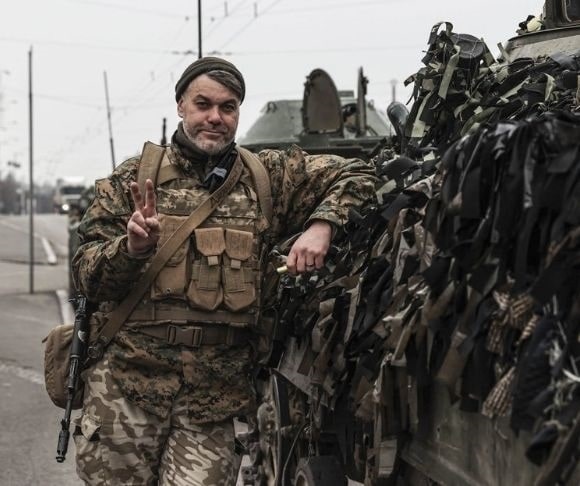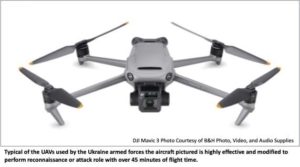
(Photo by Metin Aktas/Anadolu Agency via Getty Images)
What is “asymmetric warfare,” you ask? Put simply, it is a conflict in which a demonstrably less powerful country holds its own or defeats a much more powerful enemy by using the assets and capability it has to maximum advantage. There is no better example than what you find in Ukraine, where courage, innovation, geography, and creative use of commercial off-the-shelf resources are being turned into very effective warfighting capability. The Ukrainians use Radio Shack-level resources to meet and defeat the Russian juggernaut’s armor, missiles, and aircraft. Moscow invaded Ukraine with larger numbers of trained forces and the weight of modern, technologically superior weaponry and, by most accounts, is losing. The war in Ukraine is, at best, a standoff.
Believing the pitched battles would be over quickly, Moscow’s forces have stayed on prepared roads and highways. But the geography does not favor the Russians. Using ground routes that are often two- or single-lane streets or country roads funnels the Russian tracked infantry carriers and armor into killing windows for Javelin and other anti-tank, anti-armor weapons. Fighting in their towns and villages on familiar ground, the smaller and meagerly equipped Ukrainian military and civilian volunteers have the advantage.
If you must engage an enemy with anti-tank missiles, rifles, and grenade launchers, knowing the battleground gives you a decided leg up on the competition. The Kyiv government active-duty military troops and civilian militia members can “shoot and scoot” in a neighborhood in which they’ve lived.
Two or three Ukrainians can hide in villages or forests bordering roads and streets that they know and engage a convoy of trucks, tanks, or armored personnel carriers. The hidden Ukrainians will launch an anti-tank missile, disable the lead tank or other vehicle, kill a couple of Russian infantrymen, and run away through a familiar landscape in the resulting confusion. In that moment, the Russian soldiers and vehicle drivers take time to figure out where the missile and rifle fire came from, but the convoy is stopped. The stationary convoy allows another Ukrainian squad to hit the last vehicle in convoy. The Russians are trapped, and Kyiv’s fighters have the opportunity and time to deal with the remaining vehicles when convenient. Numerous photos from the Ukraine conflict show rows of destroyed Russian military vehicles, testifying to the value of the Ukrainian tactics.
Additionally, Ukraine’s military is making effective use of low-tech weaponry. Inexpensive $2,000 commercial drones are being used in reconnaissance and anti-tank roles. “Aerorozvidka, a specialist air reconnaissance unit within the [Ukraine] army, has been picking off tanks, command trucks, and vehicles carrying electronic equipment since the invasion began,” a battlefield account by The Times of London explained. “’We strike at night, when Russians sleep,’ Yaroslav Honchar, the unit’s battle-hardened commander, said from his base of operations in Kyiv. Russian forces are static when night falls,” The Times continued. Moreover, the innovative Ukrainians have modified the drones to carry anti-tank grenades, which play havoc with the Russian armor and trucks.

The drones are easy to carry, have high-resolution optics for continuous video, and are ideal for ground forces, providing real-time imaging capability. However, the mini-UAVs do need wi-fi to operate effectively. Enter Elon Musk. The famed Tesla CEO “and his firm Starlink have donated thousands of satellite internet-access terminals to Ukraine, including the Aerorozvidka squads, which come with a warning to camouflage the antennas,” Andy Kessler reported for the Wall Street Journal.
The Kyiv government has also been able to capture the narrative coming from the unprovoked invasion of its country. The information warfare domain is clearly favoring the Ukrainians. “The current debate now is whether Ukraine has gone even further and achieved supremacy in the information domain; this is a reality that a month ago seemed unlikely, as Russia’s use of information and hybrid warfare to achieve its strategic objectives was regarded as vastly superior to that of Ukraine’s. The tables have turned,” as Daniel Johnson put it in Task & Purpose. Stories of the Kremlin’s fighters surrendering or mutinying are plentiful. The Russian commanders in the field do not police up their dead, and the images of hundreds of Russian soldiers’ bodies in fields and along roads are not a good look for Moscow or motivational for troops doing the fighting.
Just how effective a smaller force with less equipment but plenty of motivation can be against a large army with technically superior weapons can be a hard lesson to learn. The US is no stranger to the phenomenon, thanks to time spent in Vietnam and Iraq. Now it’s Russia’s turn to be schooled on the downside of going up against a dedicated adversary with the home-field advantage.
The views expressed are those of the author and not of any other affiliation.
~ Read more from Dave Patterson.
Remember to check out the web’s best conservative news aggregator
Whatfinger.com — the #1 Alternative to the Drudge

